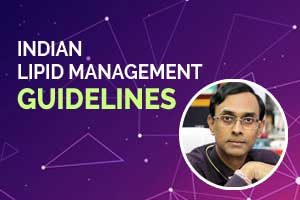- Home
- Editorial
- News
- Practice Guidelines
- Anesthesiology Guidelines
- Cancer Guidelines
- Cardiac Sciences Guidelines
- Critical Care Guidelines
- Dentistry Guidelines
- Dermatology Guidelines
- Diabetes and Endo Guidelines
- Diagnostics Guidelines
- ENT Guidelines
- Featured Practice Guidelines
- Gastroenterology Guidelines
- Geriatrics Guidelines
- Medicine Guidelines
- Nephrology Guidelines
- Neurosciences Guidelines
- Obs and Gynae Guidelines
- Ophthalmology Guidelines
- Orthopaedics Guidelines
- Paediatrics Guidelines
- Psychiatry Guidelines
- Pulmonology Guidelines
- Radiology Guidelines
- Surgery Guidelines
- Urology Guidelines
Lipid management: Indian Version of 2016 ESC/ EAS guidelines released

An Expert Panel comprising of cardiologists has released Indian adaptation of 2016 ESC and EAS guidelines for management of dyslipidemia in Indian settings. The recommendations have appeared in the Indian Heart Journal.
The burden of cardiovascular disease (CVD) in India is alarmingly high and continues to increase exponentially. Dyslipidemia being a known modifiable risk factor for cardiovascular (CV) disease, seeks attention from patients, physicians and policymakers to reduce the morbidity and mortality from CV disease.
Indian dyslipidemia is characterized by a significant prevalence of reduced high-density lipoprotein cholesterol (HDL-C) and raised triglycerides (TGs).
Speaking to Medical Dialogues team, Cardiologist, Professor Dr. Saumitra Ray, Vivekananda Institute of Medical Sciences, Kolkata and first author of the study said, "European Society of Cardiology published a very comprehensive guideline on lipid management in 2016. But it is explicitly mentioned to be applicable to the European population. So it is highly relevant for the non-European countries to formulate their own guideline or to adapt the ESC guideline with appropriate modification.”
“ We did the latter for Indian perspective. We endorsed LDLc to be the most important lipid-related risk factor and target for therapy, but at the same breath, we emphasized the importance of HDLc and Triglyceride as CVD risk factors and to target them therapeutically. We found that amongst the many available risk assessment tools, the QRISK score 2 suits the Indian population best. We recognized that a fasting lipid profile is the standard way of assessing lipids, but at the same time, we recognized the importance of random lipid profile assessment if that is the only available blood sample. We neutrally evaluated the role of both statin and non-statin pharmacotherapy in different subsets of Indian patients. And finally, we reemphasized the need for comprehensive risk factor management including hypertension, dysglycemia, increased body weight, and suboptimal diet and exercise," he added.
A panel of experts in the management of dyslipidemia, including Dr Ray provided their expert opinions to adapt the updated recommendations for Indian subset of dyslipidemia. The document provides expert consensus on adapting 2016 ESC dyslipidemia guidelines recommendations in the Indian context.
Read Also: One third of people with normal Lipid tests at high risk of CVD: SRL analysis
Some of the recommendations made by the expert panel include:
- Assess CV risk with QRISK 2 calculator in all patients in India.
- Fasting lipid assessment should be routine except in cases of CV risk assessment, in diabetes and distant locality of patients where non-fasting lipid assessment can be done.
- Five primary targets for CV risk reduction include no tobacco, physical activity, healthy diet, blood pressure control, and lowering of the glycemic load.
- LDL-C being a primary target, non-HDL-C can be considered as secondary targets after achieving primary LDL-C target, if TGs remain high (>200 mg/dl). LDL-C <70 mg/dL is target for all ASCVD cases with optional reduction to <50 mg/dL in very-high-risk cases.
- Statins are first-line drugs for dyslipidemia. Rosuvastatin, atorvastatin, and pitavastatin can be used in India. Ezetimibe should be the second agent to a statin to achieve the desired lipid targets. Other agents can be considered after statin and ezetimibe. Lower statin dose in combination with ezetimibe may be considered in patients with significant statin-related side effects.
- Addition of fenofibrate may be considered to a statin to lower TGs <200 mg/dL in India. Monitor creatinine with use of fenofibrate. Use a low dose of fenofibrate in existing renal failure cases. Intensification of lifestyle measures should be done
- For diagnosis of FH, use Dutch clinical criteria. LDL-C goal should be <70 and <100 mg/dL in patients with CVD and without CVD respectively. Statin and ezetimibe in combination are recommended as the primary treatment for FH in India until PCSK9 inhibitors become available for clinical use.
- In diabetes with high CV risk, LDL-C goal is < 70 mg/dL. Combination of modest dose statin with ezetimibe should be considered to control dyslipidemia in diabetes.
- In ACS and in patients undergoing PCI, LDL-C goal is <70 mg/dL with optional lowering to <50 mg/dL in very-high-risk cases. Statin (high dose) with the addition of ezetimibe is suggested to achieve these lipid targets.
- In non-dialysis dependent CKD, statin ± ezetimibe is advised to achieve LDL-C goal of <70 mg/dL. eGFR should guide the choice of dose. Use of high-dose statin in those with eGFR <30 ml/min/1.73 m2, consultation with a nephrologist is necessary.
- For primary and secondary stroke prevention, high-dose statins are recommended for Indians.
- Follow-up monitoring is advised after 12 weeks till goal are reached and then annually.
- Liver function assessment at baseline and post-treatment (after 4–6 weeks) should be done. CK levels should be assessed in patients with myopathy or in those at high-risk of muscle damage.
For full information log on to https://doi.org/10.1016/j.ihj.2018.03.011

Disclaimer: This site is primarily intended for healthcare professionals. Any content/information on this website does not replace the advice of medical and/or health professionals and should not be construed as medical/diagnostic advice/endorsement or prescription. Use of this site is subject to our terms of use, privacy policy, advertisement policy. © 2020 Minerva Medical Treatment Pvt Ltd